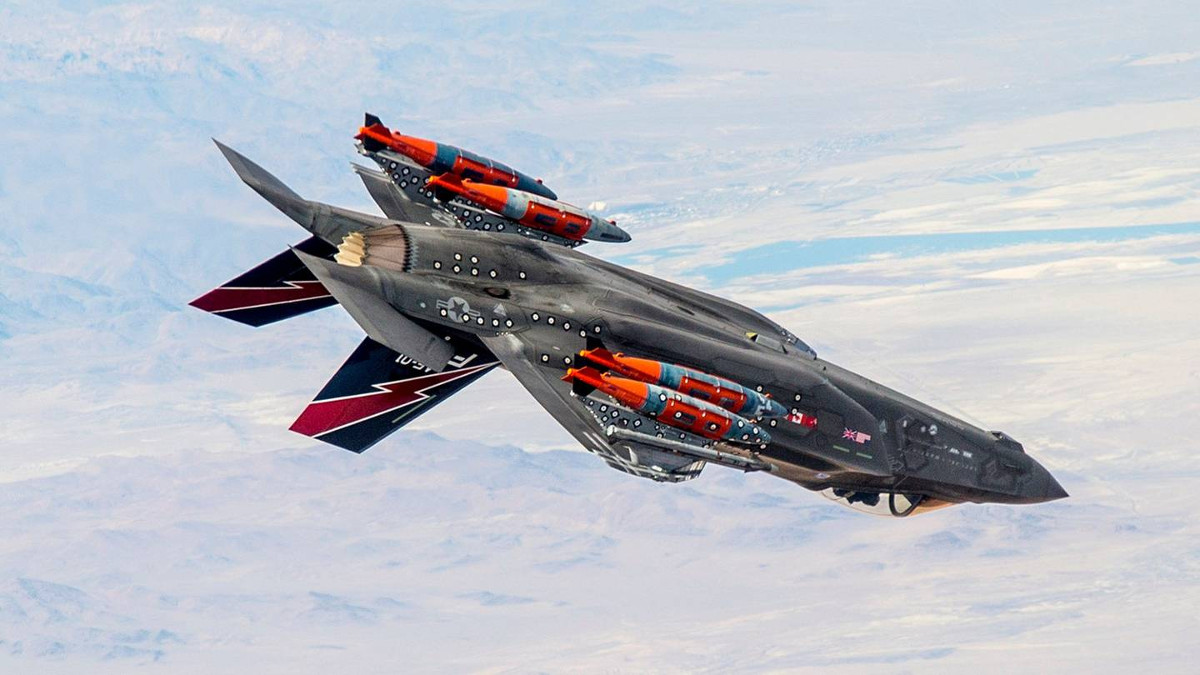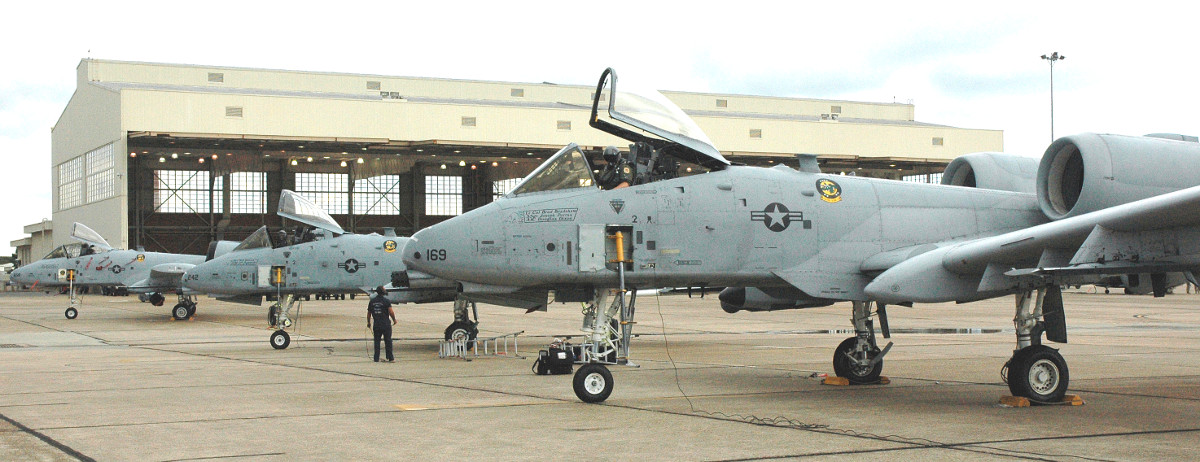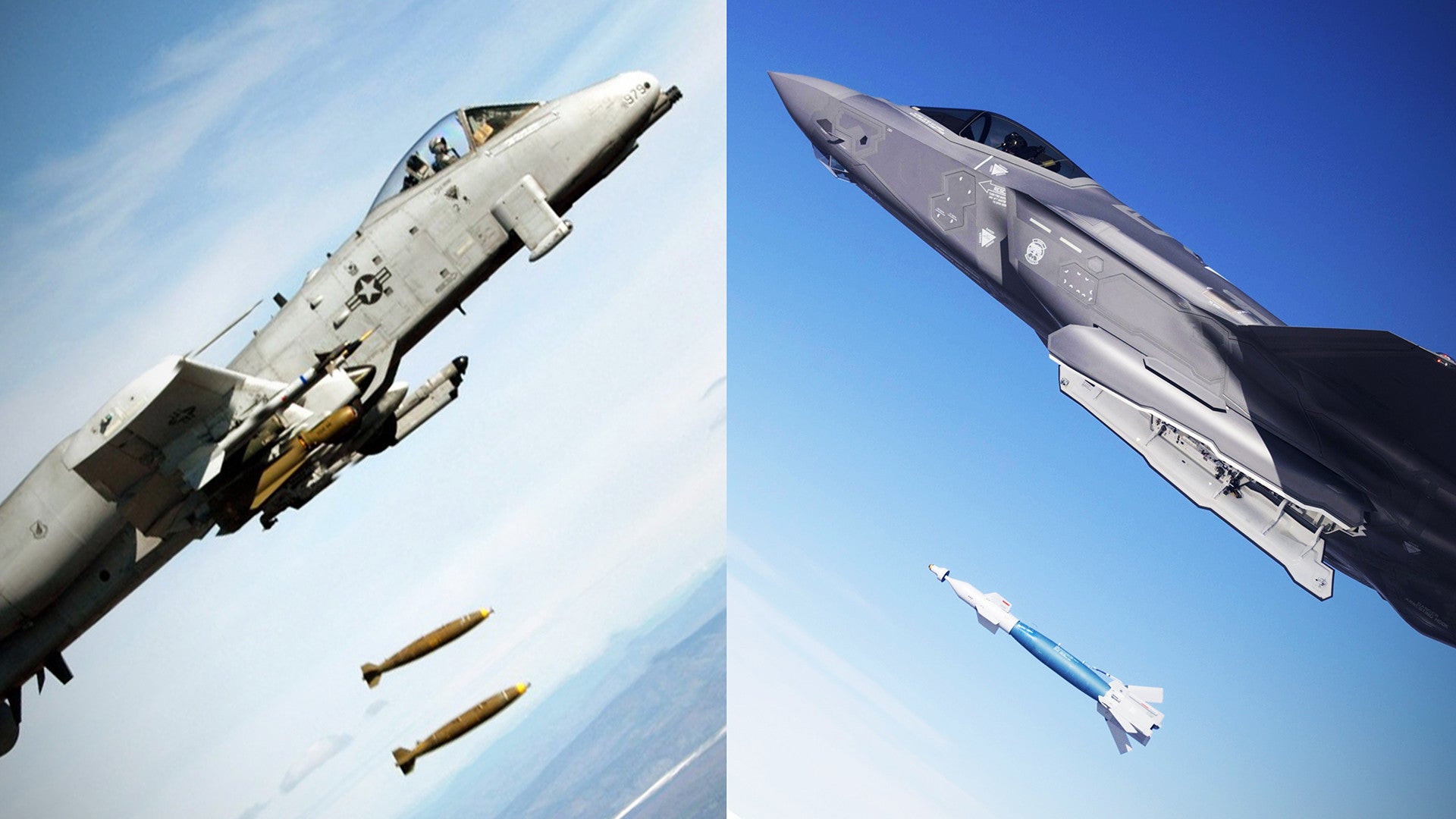The U.S. Air Force has, without any apparent public announcement, begun a much-awaited comparative evaluation of the close air support capabilities of the F-35 Joint Strike Fighter versus the venerable A-10 Warthog. The event was already controversial before it even began and there is now evidence to suggest the service maybe be manipulating the test parameters to favor the stealthy fifth-generation fighter jet.
The Straus Military Reform Project at the Project on Government Oversight (POGO) was the first to reveal the tests have already started, according to a copy of the schedule that it got a chance to review. The evaluation began on July 5, 2018, and will last just one week, ending on July 12, 2018. Only four of those days involve actual flying. The Air Force had previously said the event would occur sometime in 2018, but did not offer a fixed timeline.
“They are staging an unpublicized, quickie test on existing training ranges, creating unrealistic scenarios that presuppose an ignorant and inert enemy force, writing ground rules for the tests that make the F-35 look good,” Dan Grazier, the Jack Shanahan Military Fellow at POGO, wrote on the organization’s blog and his analysis is worth reading in full. “And they got the new testing director, the retired Air Force general Robert Behler, to approve all of it.”

According to POGO, here is how the first day of testing, which occurred at Marine Corps Air Station Yuma in Arizona, was supposed to go:
“The first day’s test—July 5, at Yuma—scheduled one F-35 two-ship flight and two A-10 pairs. Each flight was to spend one hour making attack passes at highly visible, bombed-out vehicle hulks and shipping containers simulating buildings (plus one highly visible, remote-controlled moving-vehicle target), all in flat, open terrain near a large simulated airfield target. Each A-10 carried two laser-guided 500-pound bombs, two captive-carry Maverick guided missiles, a pod of marking rockets, and only 400 30 mm cannon rounds. The F-35s carried a single 500-pound laser-guided bomb and 181 25 mm rounds, the most each plane could carry. For the last 20 minutes of each one-hour target-range session, altitude was restricted to 10,000 feet, an alleged evaluation of each plane’s ability to operate beneath low cloud cover.
“The first day’s attack scenarios called for ‘permissive’ anti-aircraft defenses consisting of simulated shoulder-fired missiles and light anti-aircraft guns. A permissive environment is one in which there are few or no threats capable of shooting down an aircraft. Despite the “permissive” description, these are the anti-aircraft weapons that close air support planes will typically encounter while supporting our troops in battle against near-peer maneuvering enemy forces. However, the simulated defenses at Yuma had no precision instrumentation to track aircraft flight paths, gun aiming, or missile launch and homing. As a result, no quantitative data regarding the actual performance of the A-10 and F-35 will have been gathered. Rather than having charts of performance data, the evaluators will simply be able to report any results they want, without any way to verify the reports.”

And here is a description of the remaining three testing days at Naval Air Weapons Station China Lake in California:
“The day two schedule—July 9 at China Lake—calls for four F-35Bs to conduct a mission covering two Ospreys extracting a pilot downed in enemy territory for one hour, then four A-10s covering a similar extraction. A similar set of missions under night conditions is scheduled for the late evening of day three.
“On the afternoon of day three, A-10 and F-35 pairs are to spend an hour and a quarter on the China Lake target range attacking static, visible targets similar to the Yuma targets—but these are even less realistic, as they are just simulated attacks, with no weapons released. The stated reason for moving to China Lake, despite the restrictions on actually firing weapons, is to test the A-10 and F-35 against the range’s “elevated” anti-aircraft defenses, which include simulated medium-range surface-to-air missiles, as well as shoulder-fired short-range missiles and light anti-aircraft guns.
“On the afternoon of the final day, a pair of A-10s and a pair of F-35s will undergo tests to gauge their ability as airborne forward air controllers, directing the strikes of at least three sections of F-18Cs, which will simulate the bombing of more uncamouflaged targets, against the same medium- and short-range air defenses. In the late evening, a pair of F-35s and a pair of A-10s will conduct night close air support against the same targets and defenses.”
In his own analysis, Grazier noted that these test parameters give no weight to the A-10’s substantially greater endurance over the F-35, loiter time that can be essential during a close air support mission backing up troops in the middle of a battle that might last hours or even days. There is similarly no attempt to evaluate respective sortie rates, which is an important consideration “because combat doesn’t pause to wait for airplanes to become available,” as the Jack Shanahan Military Fellow wrote.
In addition, setting a 10,000-foot operational ceiling during the Yuma test day was particularly generous to the F-35, given that low cloud cover can often force aircraft to fly below 1,000 feet, an environment where the A-10 excels. There is also apparently no specific mention of highly specialized equipment to precisely gauge the accuracy of various simulated anti-aircraft threats, which Grazier warns could lead to subjective bias creeping into the post-evaluation analysis of the outcomes of all four days of evaluations.

And for unexplained reasons, neither the A-10s nor the F-35s were carrying either of their respective maximum weapon load outs in any of the events. The decision to only load the magazines for the Warthog’s massive GAU-8/A Avenger cannon with less than half of the maximum number of 30mm cannon shells they can carry seems especially arbitrary.
There were also possible limits the ability of the F-35 to perform since there is no apparent comparative evaluation within the comparative evaluation that takes into account the jet in its full-stealth configuration versus the aircraft with its external weapons pylons installed. One clear possibility, which the POGO analysis notes, is that the Air Force made its decision to only load up the Joint Strike Fighters with just one 500-pound class bomb internally in order to lighten them and improve their maneuverability.
Otherwise, it would seem that the service had put the stealthy fighters at a distinct and equally artificial disadvantage when it comes to engaging multiple targets for no reason. That being said, we also don’t know what the objective number of targets each type of aircraft had to hit was, or how else the evaluators assessed how well the planes “destroyed” their mock opponents, which could make this a moot point.

The test targets at Yuma themselves were another concerning element of the evaluation. There is no indication that the evaluators arranged the static and mobile vehicle type targets, or the stacked shipping containers standing in for structures, in such a way as to reflect a realistic close air support scenario. Yuma’s bombing range is relatively flat and open, which would make the mock threats easy to spot, as well.
This would all seem to be intended to help the F-35 pilots who would have to rely heavily on the aircraft’s increasingly dated Electro-Optical Targeting System, which is based on technology that is now more than a decade old, to spot targets. Though the Joint Strike Fighter has the ability to fuse additional information from other sensors, such as the AN/APG-81 radar and AN/AAQ-37 Distributed Aperture System, as well as information from other aircraft, this is unlikely to be of much benefit in a close air support situation. Depending on how the test parameters take into account mock anti-aircraft defenses, this might give the F-35 an advantage by helping the jets to avoid those threats, though.

The F-35 also lacks the ability to engage moving targets when it’s not carrying one specific type of precision-guided bomb, an issue you can read about in more detail here, and doesn’t have an an infrared pointer to help confirm targets with personnel on the ground. These are important tools in any close air support situation.
In contrast, A-10s can carry more recent iterations of Lockheed Martin’s Sniper Advanced Targeting Pod and Northrop Grumman’s LITENING targeting pod. It also has the onboard moving target and infrared pointer capabilities that the F-35 lacks.

And if, after all this, one feels that there is still something glaringly missing, you’re not wrong. According to POGO, it’s entirely unclear how, where, and when Joint Terminal Air Controllers (JTAC), specially trained personnel on the ground who coordinate close air support and other air strikes, fit into the tests or if they do at all.
The F-35’s ability to engage with JTACs is an essential consideration, especially given that the aircraft still lacks Remotely Operated Video Enhanced Receiver (ROVER) or any similar capability. This system allows equipped aircraft to beam the video feeds from their sensors straight to personnel on the ground in near real time, allowing both parties to better and more rapidly identify and confirm targets.

Without this system, or another set of equipment that offers an equivalent capability, Joint Strike Fighter pilots could find it much more difficult to quickly separate enemy forces from friendly troops and innocent civilians when it matters most. We don’t have to speculate about how bad things can get, either.
In October 2015, a U.S. Air Force AC-130U made a horrific mistake and blew apart a hospital that the non-governmental organization Médecins Sans Frontières (MSF), or Doctors Without Borders, was operating in Kunduz, Afghanistan. In its investigation, the U.S. military found that the gunship’s ROVER system, along with other data links, were malfunctioning, forcing the aircraft to try and locate its target using only verbal descriptions over the radio from JTACs blocks away from the actual fighting.
According to POGO, none of this is particularly surprising. The sources that shared the information, who asked to remain anonymous out of a very real fear of retaliation from senior Air Force leadership, said the service had crafted the test plan without talking to a single member of the A-10 or JTAC communities or the 422nd Test and Evaluation Squadron, which provides Warthogs and Joint Strike Fighters, among other types, for test purposes. Army and Marine Corps personnel were also conspicuously absent from the discussions. Tactical Air Support Inc., also known simply as TacAir, a private contractor that provides air-to-air and air-to-ground training support to the Air Force, led the development of the evaluation program.
It’s worth noting that the Air Force has gone on the record to voice its opposition to this evaluation in the first place on more than one occasion. “I think that would be a silly exercise,” then-U.S. Air Force Chief of Staff General Mark Welsh notably said of the proposed fly off in 2015.

Welsh eventually got reminded that J. Michael Gilmore, then the Pentagon’s Director of Operational Test & Evaluation, had included the comparative testing in the Initial Operational Test and Evaluation plan for the F-35 regardless of his opinions on the matter. Then, in 2016, Congress added a clause into a defense spending bill mandating that the tests occur.
To be fair, Welsh wasn’t entirely wrong. Pitting the F-35 against the A-10 is comparing apples and oranges and the outcome can only stir up controversy. The flyoff is unlikely to uncover anything the Air Force and independent experts don’t already know, chiefly that the two aircraft both have very real places in the Air Force’s force structure.
At the same time, the Air Force deliberately put itself in this situation by insisting that the F-35 would be a suitable direct replacement for the A-10. This is to say nothing of the Air Force’s repeated attempts to retire some
or all of the Warthog fleet, or otherwise cripple
their capabilities to force that decision, in spite of an almost equal number of Congressional stipulations that specifically bar it from doing so.
The service went so far as to suppress an official short documentary film about the Warthog’s contributions to the U.S. campaign against the Taliban and other insurgents and terrorists in Afghanistan. You can finally watch the video in its final form below thanks only to a Freedom of Information Act request.

That decision came after now-retired Air Force Major General James Post caused a massive public outcry by telling his subordinates that it was tantamount to treason to contact legislators and voice support for the A-10s. Shortly after that, the Air Force released a highly manipulated data set to exclusively to USA Today in an attempt to falsely present the Warthogs as a liability to troops on the ground, another example of the service actively doctoring information to discredit the popular aircraft.
“The Congressionally approved plan includes a schedule for tests and funding for elaborate tactical test ranges with combat-realistic, hard-to-find targets defended by carefully simulated missile and gun defenses, and appropriate ground-control teams for the close-support portion of the test scenarios,” POGO’s Grazier wrote. “Rather than telling us whether or not the F-35 can actually provide the kind of close support our ground forces need to survive and prevail, this grossly inadequate test has been designed to mislead.”
With all this in mind, it will be especially interesting to see how the Air Force responds to these revelations and what information it decides to provide to the public now that the fly off has become public knowledge whether they like it or not.
Contact the author: jtrevithickpr@gmail.com
